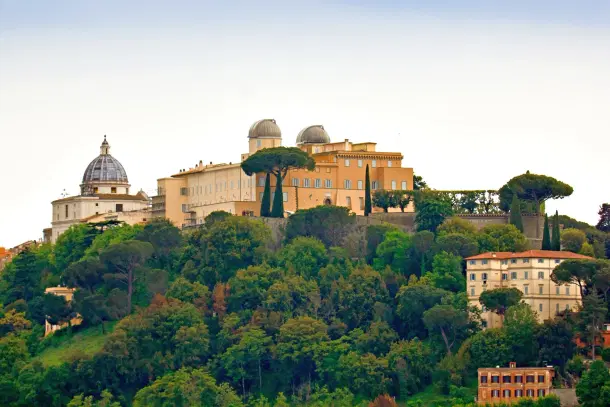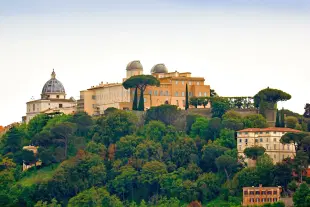Ideas
Why The Appointment Of An Indian Jesuit As Vatican Observatory Director Is A Wake-Up Call For Hindu Ecosystem
Aravindan Neelakandan
Aug 09, 2025, 10:14 AM | Updated Sep 01, 2025, 03:31 PM IST
Save & read from anywhere!
Bookmark stories for easy access on any device or the Swarajya app.


It is for the first time, an Asian—and an Indian, no less—has been appointed director of the Vatican Observatory.
Pope Leo XIV has selected Dr. Richard Antony D'Souza SJ for the post. Born in Pune, the astrophysicist of the batch of 2002 hails from Goa.
This is an important milestone. To understand its full impact one should look at the engagement of the Church with science.
Since the Enlightenment, popular imagination in West has been captive to a narrative of perpetual conflict between science and religion. A striking and instructive paradox to this story, however, endures within one of the Christian faith’s oldest citadels: the Vatican Observatory (Specola Vaticana).
With foundations in the 16th century and formally re-established in 1891, the Observatory is a testament to a sophisticated institutional strategy. It reveals how the Holy See has not merely patronised science, but masterfully leveraged astronomical research to manage its public narrative, reinforce theological boundaries, and exert a formidable soft power on the world stage.
The recent appointment of a new director for the Observatory, Father Richard D'Souza, S.J., reaffirms this dual mission: to conduct world-class science and to champion a specific vision of the relationship between faith and reason.
This strategic masterclass in scientific engagement holds profound lessons for other world religions, particularly for a tradition as philosophically rich and ancient as Hinduism. While modern Hindu thought often celebrates a natural harmony between its core tenets and the discoveries of modern physics, this philosophical resonance is not matched by a coherent institutional strategy.
The Hindu world, with its vast intellectual heritage, suffers from an institutional fragmentation that prevents it from leveraging this harmony on the global stage with the same strategic effectiveness as the Vatican.
The Vatican's Celestial Blueprint: Science as a Strategic Asset
The Vatican's deep engagement with science is no happy accident. It is a calculated, long-term strategy forged in the crucible of historical conflict. It was a strategic response to the pervasive 19th-century narrative of an irreconcilable war between science and religion, which brandished the 17th-century trial of Galileo as its prime exhibit.
The Vatican astutely recognised that theological arguments alone were insufficient to counter this powerful cultural narrative. A more tangible, public demonstration was required.
Thus, the re-founded Observatory, with Pope Leo XIII's Motu Proprio, "Ut mysticam", was positioned as a "significant instrument of institutional messaging and a symbol of reconciliation between faith and reason".
Its very existence was designed to embody a counter-narrative of harmony. This marked a fundamental shift in institutional strategy: from direct confrontation, as seen in the Galileo affair—which Pope John Paul II would later term a "tragic mutual incomprehension" —to a more sophisticated approach of co-optation and patronage.
The Church learned a crucial lesson: if it could not defeat science in a public war of ideas, it could become one of its most visible and credible patrons.
This strategy, however, would have been hollow without authentic scientific credibility. The Church understood that the rhetoric of compatibility is meaningless unless backed by high-caliber, globally integrated scientific work. From its re-founding, the Observatory was tasked with participating in the ambitious international "Carte du Ciel" (Map of the Sky) project, the first large-scale international scientific collaboration ever conceived.
The Vatican's contribution was substantial, involving the meticulous cataloging of data from thousands of glass-plate photographs over several decades. A remarkable and often unsung aspect of this effort was the work of four Sisters of the Holy Child Mary—Emilia Ponzoni, Regina Colombo, Concetta Finardi, and Luigia Panceri—who between 1910 and 1921 painstakingly measured and recorded the positions of 481,215 stars.
This commitment to scientific excellence continued throughout the 20th century.
When light pollution from Rome began to hinder observations in the 1930s, Pope Pius XI ordered the Observatory's relocation to his summer residence at Castel Gandolfo, prioritising optimal research conditions over historical location. The crowning achievement of this pursuit of credibility is the Vatican Advanced Technology Telescope (VATT), established in 1993 on Mount Graham, Arizona—one of the world's premier astronomical sites.
The VATT is not merely a user of technology but a pioneer. Its 1.8-meter primary mirror was the "first ever made using the new technique called spin casting," an innovation that "fundamentally changed how large telescope mirrors are fabricated worldwide" and was subsequently adopted for next-generation behemoths like the Giant Magellan Telescope.
By advancing the entire field's capabilities, the Church positioned itself as a benefactor to its potential intellectual rivals, a sophisticated diplomatic manoeuvre that builds immense goodwill.
The scientific output from these facilities is verifiably high-impact. Research conducted with the VATT has been published in leading journals like Nature and the Astronomical Journal, with high citation counts on topics ranging from the colour classification of Kuiper Belt Objects to work that was crucial in eliminating the MACHO (Massive Compact Halo Objects) hypothesis as a primary explanation for Dark Matter.
The deep integration of Vatican astronomers within the scientific community is underscored by collaborations like that of the late Father Bill Stoeger, S.J., with Stephen Hawking and George Ellis on developing detailed models of the Origin question.
This sustained investment in credible, frontier science has earned the Vatican its seat at the table. It has also provided the Church with a platform to navigate the delicate metaphysical boundaries between science and theology.
The widely cited anecdote involving Pope John Paul II and Stephen Hawking at a 1981 Vatican cosmology conference is a crucial case study. Hawking recounted that the Pope told scientists they should not inquire into the Big Bang itself, "because that was the moment of creation and the work of God". This framing, which Hawking cheekily linked to the fate of Galileo, reinforced the very conflict narrative the Observatory was created to dispel. So the tensions have not entirely disappeared.
The Vatican's scientific work is amplified through a sophisticated "soft power" infrastructure. The Vatican Observatory Summer Schools (VOSS) have cultivated a global network of over 400 alumni, many now in senior academic positions, who hold a positive view of the Church's role in science.
The "Astronomy for Catholic Ministers and Educators (ACME) workshops" ensure internal alignment, equipping priests and teachers to teach science-faith compatibility. High-level collaborations, like the long-standing partnership with the Center for Theology and Natural Sciences (CTNS) in Berkeley, have produced a highly acclaimed book series exploring "divine action" in fields like quantum mechanics, chaos theory etc. , positioning the Vatican as a thought leader.
The publications include titles like: 'Quantum Cosmology and the Laws of Natures: Scientific Perspectives on Divine Action' (1993) & 'Chaos and Complexity: Scientific Perspectives on Divine Action' (1995) etc. to name a few.
This vertically integrated strategy, targeting future leaders, internal clergy, and the academic vanguard, is the secret to the Vatican's success.
The Hindu Paradox: Deep Darshanic Resonance, Institutional Fragmentation
In stark contrast to the Vatican's carefully managed strategy, a dominant narrative within modern Hinduism posits a deep and natural harmony between its core Darshanas and the discoveries of modern physics. This "harmony narrative" serves a crucial post-colonial function, allowing modern Hindus to engage with global scientific modernity from a position of confidence and intellectual parity.
The single greatest obstacle preventing Hinduism from leveraging its philosophical richness on the global stage is its institutional landscape. Unlike the centralized, strategically-driven Vatican, the Hindu ecosystem is vast but fragmented. It critically lacks a flagship institution that mirrors the Vatican Observatory's dual-mission model: performing credible, high-impact primary science and using that credibility as a platform for philosophical dialogue.
The landscape of Indian Science in this regard can be categorized into four distinct, largely non-overlapping domains.
First, India's world-class scientific powerhouses, like the Indian Institutes of Technology (IITs) and the Indian Institute of Science (IISc), are constitutionally secular and operate independently of any religious framework. Their mission is national development, not any civilizational dialogue, nor engagement with Indian Darshanas.
Second, a vast network of institutes focuses on traditional systems like Ayurveda and Yoga, but their research is primarily focused on validating traditional health practices, not fundamental science and much less cosmology.
Third, there are indeed many modern Gurus who have emerged as flag bearers of Hindu Renaissance. However there is in most of them (not all) a strong cult element. They have become the stereotypical face of Hinduism in the modern times, both in India and abroad. They often use the Q-word to promote pseudo-scientific and anti-science claims. Their so-called scientific research are mostly self-congratulatory explorations with a very myopic marketing perspective.
Finally, academic civilizational knowledge systems are slowly emerging platforms. These platforms can become vital for scholarly conversation but still they lack an in-house research component or the institutional scale of the Vatican's multifaceted efforts.
This institutional fragmentation is the root of the strategic disadvantage.
The Need for Action in the Shadow of the Vatican's New Strategy
The Vatican’s appointment of Father Richard D'Souza, S.J., an Indian Jesuit, as the new director of the Vatican Observatory is a masterstroke of strategic foresight. It is a move that should serve as a resounding wake-up call for Hindu spiritual leaders, scientists, and thinkers.
While the Hindu world celebrates a philosophical harmony with science, the Vatican has reached into the heart of India to recruit top intellectual talent to lead its global science-theology enterprise. This is not just an appointment; it is a symbol of a dynamic, forward-looking institution adapting to a 21st-century global landscape, and it throws the institutional lacunae within the Hindu world into stark, unavoidable relief.
The lessons from the Vatican's playbook are no longer theoretical suggestions; they are urgent imperatives. As the Church demonstrates its ability to co-opt the world's best minds for its mission, the window of opportunity for the Hindu community to build its own authentic, scientifically-grounded spiritual enterprise is closing. To move beyond philosophical self-congratulation and institutional fragmentation, a strategic and immediate project of institution-building is essential.
The lack of a dual-mission research centre is now a critical vulnerability. It is no longer sufficient to point to parallels between Vedanta and physics in books and at conferences. A world-class, well-funded but scientifically rigorous, independent research institute—focused on a field with deep resonance like Consciousness Studies and/or Theoretical Physics—is an immediate necessity. Its mission must be twofold: to produce high-impact, peer-reviewed primary science, and to house a permanent centre for philosophical dialogue exploring this research through a Dharmic lens.
Without a single, globally-recognized address with unimpeachable scientific credibility, the Hindu voice on the world’s most profound questions will continue to be marginaliwed, drowned out by institutions that have done the hard work of building them.
The appointment of an Indian director at the Vatican highlights a painful irony. While 'India that is Bharat' produces world-class scientific talent, her own religious and philosophical traditions lack the institutional pathways to harness this talent for their own intellectual and spiritual advancement. A network of educational programs is needed now to reverse this trend. This must include:
Vedanta-Vigyan Summer School, to cultivate the next generation of interdisciplinary leaders from India and around the world.
Acharya Advancement Program, which are workshops, to urgently equip Hindu priests (pujaris), teachers, and community leaders and activists with the tools to engage with science accurately and constructively. This can be done differently to equip each of the groups stated above.
But both the movements, VVSS and AAP, should aim to provide the spirit of science, facts and trends in science and universal spiritual values in an uncompromising way and should not devolve into camps for self-congratulations.
This entire enterprise must be driven by a renewed sense of purpose. The appointment of an Indian to lead a premier Vatican institution should be the catalyst that moves the Hindu identity from a post-colonial celebration of past glories to the proactive building of future ones.
Celebrating the historical achievements of Indian science, from Panini to S.N. Bose, is vital. But it is not enough. This moment demands the creation of new institutions that are resolutely forward-looking. This is the ultimate lesson for a modern, global religion: learn from the strategies of others, but build with urgency for your own unique future before the opportunity is lost.
The choice is between rising to the occasion or becoming a philosophical relic whose best minds are co-opted to serve the strategic missions of others.
Meanwhile, as a fellow Indian one is naturally proud to see Dr. Richard Antony D'Souza SJ, take on this role.
At the same time, one also hopes that he uses his civilizational heritage and quest for truth through science to make his Church more harmonious, more receptive to theo-diversity, and thus being universal rather than expansionist.
Congratulations, Dr. D'Souza!





